
by Lucas Joel Friday, October 14, 2016
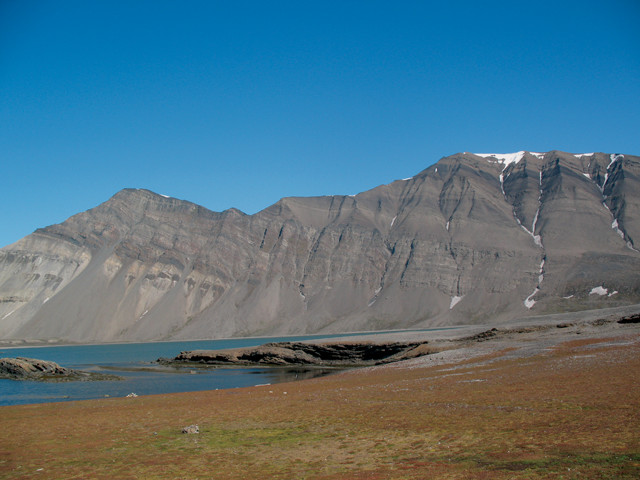
The mountains at Van Keulenhamna in southern Spitsbergen, Svalbard, expose the Permian-Triassic boundary, which forms the main step in the cliff line (V-shaped notch in middle of page) where Permian cherts give way to Triassic shales. Credit: Paul Wignall.
About five years ago, paleobiologist Matthew Clapham was walking along Panther Beach on California’s coast when something caught his eye. He reached down, picked it up, and quickly became overjoyed. It was a living brachiopod: a marine animal similar to bivalves that are so rarely encountered in today’s oceans that Clapham, who studies the fossils of animals like brachiopods at the University of California, Santa Cruz, had never found a living specimen before that day, and he has not found one since.
What makes brachiopods relatively scarce was the largest mass extinction in life’s 3.5-billion-year history, called the Permian-Triassic (P-T) mass extinction, which happened about 252 million years ago. The extinction extinguished most life everywhere: as much as 96 percent of all marine species disappeared, and about 75 percent of all land species died off.
On land, forests vanished and were replaced by what Cindy Looy, a paleobotanist at the University of California, Berkeley, calls “impoverished vegetation” — species-poor plant communities consisting of smaller plants, like the lycopsid Pleuromeia, a 1- to 2-meter-tall stem with a spore-bearing cone at the top. In the oceans, coral reefs disappeared and brachiopods were hard hit. The latter never recovered their former glory. Once commonplace, brachiopods exist today mostly in the deep ocean, not in shallow waters near beaches. Elsewhere on land, vertebrate die-offs made room for the proliferation of new animals that would eventually evolve into the dinosaurs.
Researchers largely agree that massive flood basalts — long-lasting, large and broad-scale volcanic activity — in what is today Siberia are what triggered the extinction. There, about 3 million cubic kilometers of lava erupted in about 1 million years, a relatively short time span, geologically. The remnants of the eruption exist today as the Siberian Traps, layers of basalt rock up to 3,000 meters thick covering about 2.5 million square kilometers.
But the lava, while destructive for life where it erupted, was not what ultimately caused the global extinction; greenhouse gases, namely carbon dioxide, emitted by the eruptions would have set off a cascade of devastating effects that likely impacted the global climate system. In this way, scientists understand the extinction in broad strokes: Volcanism triggered extermination. But many details remain elusive, such as how, exactly, volcanism and greenhouse gases wiped out so much life, and what the longer-term consequences were for the evolution of life afterward. As researchers work to answer these questions, other scientists are wondering what the P-T event might be able to teach us about current warming and species diversity loss, which some call the world’s sixth mass extinction.
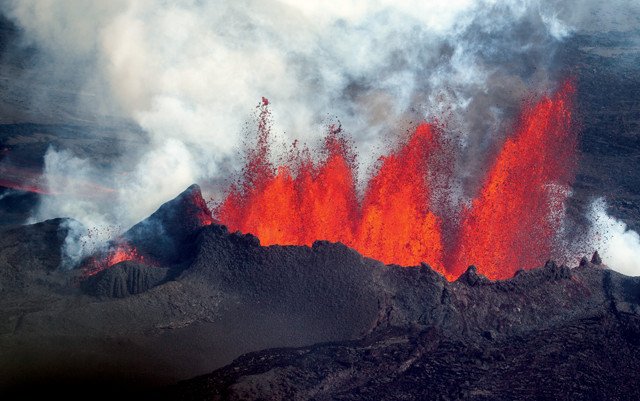
In 2014, Iceland's Bárdarbunga Volcano erupted, opening up fissures in the Holuhraun lava field. The Siberian Traps eruptions may have looked similar, but on a vastly larger scale. Credit: ©iStockphoto.com/GISBA.
The marine extinction defines the boundary between the Permian and Triassic periods. It also marks the end of the Paleozoic Era, which lasted about 290 million years, and the beginning of the Mesozoic, which lasted until about 66 million years ago when a bolide hit the planet and another wave of flood basalts, this time in India, conspired to finish off the nonavian dinosaurs. That event, called the Cretaceous-Paleogene extinction, was the most recent mass extinction, the fifth of what paleontologists call the “Big Five.”
Flood basalts, which form when superheated magma from Earth’s mantle penetrates and heats the crust, causing lava to flow continuously from fissures, are not so uncommon on Earth. In the United States, flood basalts formed Oregon and Washington’s Columbia Plateau as lava poured from fissures between 16.7 million and 5.5 million years ago, covering about 210,000 square kilometers of Idaho, Oregon, Washington and part of Nevada. For comparison, the lava that erupted in Siberia at the end of the Permian would cover much of the contiguous United States.
The volcanism that fed the Siberian Traps began about 252 million years ago, pouring out flow after flow of lava for roughly 1 million years. The eruptions also emitted gases, mainly carbon dioxide and sulfur dioxide, and the magma vaporized nearby coal deposits, emitting even more carbon dioxide. Once in the atmosphere, carbon dioxide gas traps heat released from Earth’s surface, holding in energy that would otherwise return to space. The sudden increase of carbon dioxide and the resultant warming had global consequences, both in the oceans and on land.
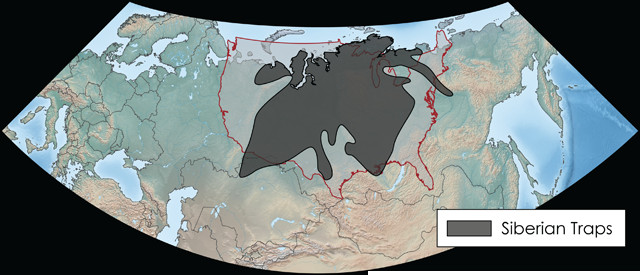
The 3 million cubic kilometers of lava erupted to form the Siberian Traps would cover much of the contiguous United States. Credit: K. Cantner, AGI.
While there is no modern-day equivalent for the P-T boundary volcanism, there is evidence that the “annual release of carbon dioxide emissions today from burning fuel is about the equivalent of one of the gigantic flows of the Siberian Traps,” says paleontologist Paul Wignall of the University of Leeds in England. However, it’s still unclear how much gas the eruptions emitted in total. “It’d be nice to have a handle on that,” Wignall says.
Scientists use proxies, like fluctuations in the carbon isotope record across the boundary, and they also look to modern volcanism for an estimate of gas release. For example, researchers have tried to scale up the gas released from Kilauea Volcano in Hawaii, which also erupts basalt, to the volume of the Siberian flood basalts, but the models suggest that wouldn’t yield enough carbon dioxide to do real damage, Wignall says. That has led some researchers to suggest that another process may have affected the planet, like an asteroid impact that could have egged the extinction on, but, for lack of strong evidence — for instance, a crater — volcanism remains the primary culprit. “That’s your giant smoking gun, if you like,” Wignall says.
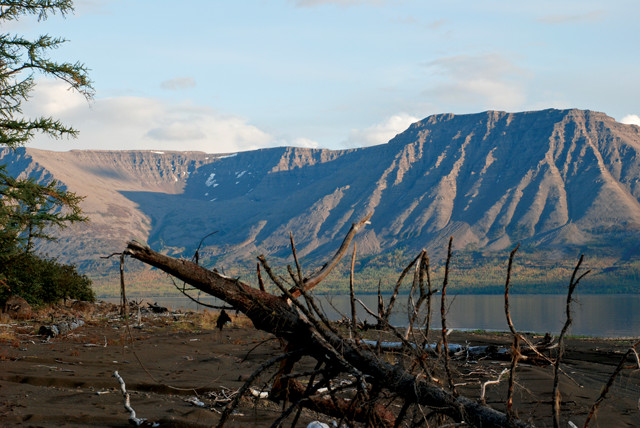
The Siberian Traps lava flows near Norilsk, Russia. Credit: ©Shutterstock.com/Sergei Drozd.
The P-T extinction event, as preserved in the fossil record, shows the abrupt disappearance of both marine and land-based plants and animals. Before the extinction started, Clapham says, the seafloor was covered in “meadows” of crinoids and “bushes” of bryozoans. These animals would affix themselves to the seafloor and then reach up into the overlying water column for food. Crinoids, often called “feather stars,” are stalked animals with mop-like heads, and bryozoans are filter-feeding, tentacled animals that typically live in colonies. Among the meadows were innumerable brachiopods, like the living one Clapham discovered at the beach. “The extinction severely affected less active and more heavily calcified organisms like corals, brachiopods and bryozoans,” which incorporate calcium into their bodily makeup, Clapham says.
floor was unrecognizable: There was just one crinoid genus left, the brachiopods had nearly all vanished, and the bryozoans suffered severe losses as well. “There probably would have been fewer individuals per given area after the extinction,” Clapham says. That, and with animals like crinoids and bryozoans so severely affected, few species that extended high into the water column for food remained: “nearly everything after the extinction would have lived really close to the seafloor,” he adds.
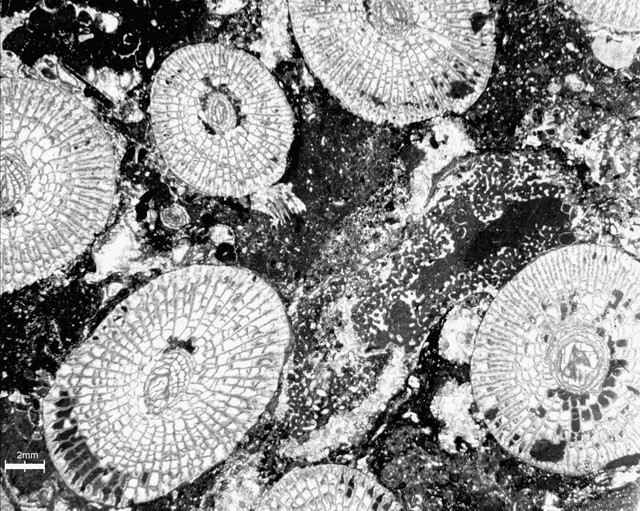
A cross section of rugose, or horn, corals, which were wiped out during the P-T extinction. Credit: Shuzhong Shen.
The extinction, while cataclysmic, allowed for life in the oceans to reorganize itself; animal groups such as the bivalves, previously marginalized by the more dominant brachiopods, evolved into ecosystems now devoid of life. Life also went subterranean: before, few animals lived under the seafloor’s surface, but after the extinction, organisms that burrow, such as clams, proliferated. “Life was evolving into an empty world,” says Michael Benton, a vertebrate paleontologist at the University of Bristol in England. Reefs, like those composed of rugose, or horn, coral vanished. “In the modern world and in the past, reefs and forests are locations of highly species-rich communities,” Benton says. If you cut those out, he says, the level of loss is truly profound.
Most of what scientists know about the P-T extinction comes from the shallow marine fossil record, which is more complete than the terrestrial fossil record. This is because the likelihood that an organism will become preserved in the oceans, where sedimentary deposition and burial is more consistent, is greater. This somewhat blurs our understanding of the terrestrial extinction, but as far as paleontologists can tell, it likely started at about the same time as the marine extinction, and the results seem to have been just as drastic.
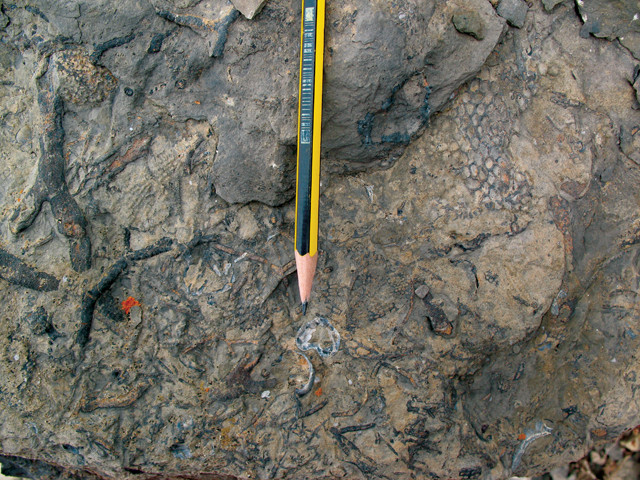
Bryozoan fossils from Eholmen at Svalbard. Bryozoans were victims of the P-T extinction. Credit: Paul Wignall.
As recently as the 1980s and the 1990s, many researchers did not think the extinction affected land life as severely as it affected life in the oceans. More recent work, though, especially in the Karoo Basin of South Africa, reveals a different story. In the Karoo, rock layers formed through time signify massive terrestrial change: in a study in Science in 2000, Peter Ward, a paleontologist at the University of Washington, and a team of co-authors revealed how, moving up through time across the P-T boundary, there is a change from sediment deposited by meandering rivers to sediment deposited by braided rivers. Plant roots, the team reported, helped the ancient meandering rivers retain their shape, but, as vegetation started to disappear, the substrate began to loosen, paving the way for braided rivers to form.
The plant fossil record across the boundary is spotty. “Plant macrofossils are rare and almost exclusively preserved in wet, nearshore, riverine or swampy environments,” Looy says. What this means is that Pangea’s interior, which many scientists think was largely arid, recorded virtually no plant fossil record. Furthermore, once the extinction ended, coal, which forms from decayed plant matter, did not appear for another 20 million years, Wignall says, leaving the so-called “coal gap,” which indicates plants didn’t repopulate land for quite some time. Coal disappeared from the terrestrial rock record at the time of the P-T extinction and didn’t reappear until the Mid-Triassic about 243 million years ago. “You go from a lush, forested landscape to a rocky” landscape that looks more like it did before plants developed on land, Benton says.
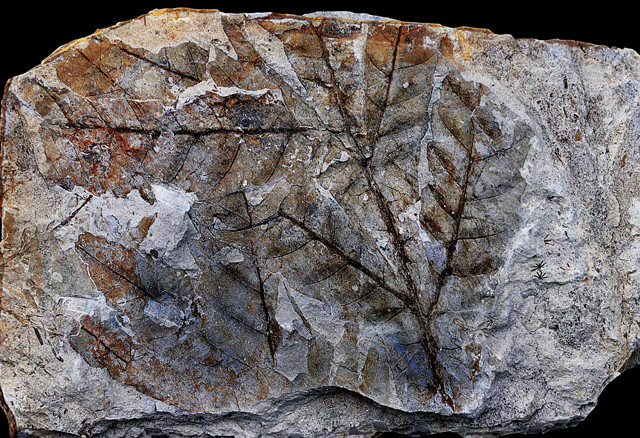
Fossil specimen of the plant Gigantopteris, which went extinct during the P-T extinction. Credit: Shuzhong Shen.
A more continuous record of how plants fared through time exists in fossilized pollen and spores, which plants produce in abundance. Fossilized pollen and spores, while not revealing specific species, can indicate which larger plant group they came from. “From that we know that large and ecologically very important plant groups were wiped out completely or were severely marginalized,” Looy says.
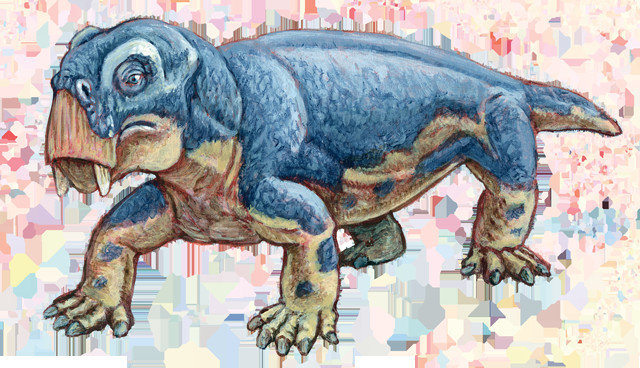
An illustration of the dicynodont Lystrosaurus, an herbivore that survived the extinction event and thrived for a short time before going extinct in the Early Triassic. Credit: artwork by Matt Celeskey, courtesy of the New Mexico Museum of Natural History and Science.
“The pollen and spore records also indicate that the initial floral turnover began at the same time as the marine extinction. Before the event, in what is today central Europe, diverse conifer and seed fern forests predominated, Looy says. After, it was “impoverished vegetation with lycopods and seed ferns.” Researchers know that all trees were gone, and the landscape was fundamentally changed, but, she adds, “there is much more that we do not know about the plant extinctions than things we do know.” Still, paleobotanists can postulate. Plants do not rely on other organisms for their food, and they also have “multiple tricks up their sleeves to overcome bad conditions,” Looy says. “For instance, many have seed or spore banks that lay dormant for many, many years, giving some the capability to recolonize even a decade after the death of their parent plants.” This may be one reason why, compared to marine organisms, the terrestrial plant die-off appears relatively less severe.
" and dicynodonts, the latter of which were the dominant herbivores at the end of the Permian. These creatures inhabited ecosystems as diverse as those that exist today and, just as with modern ecosystems, plants were a primary food source at the base of the food web. So, while it stands to reason that a mass extinction of plants should have yielded extinctions of organisms that fed upon them, Looy says, there is little known fossil evidence revealing how animal and plant extinctions coincided. Fossil evidence does show, though, that the dicynodonts, which looked like a cross between a hippo and a pig, made it through, but just barely: They were abundant in the Permian and only a few genera persist past the extinction boundary. All eventually went extinct in the Triassic.
" that included particularly large temperature increases around the equator, possibly 15 to 16 degrees Celsius, Benton says. “That’s a pretty huge change, and that’s enough to drive out all life around the equator,” he says. While some plants and animals could migrate away from equatorial latitudes, most perished.
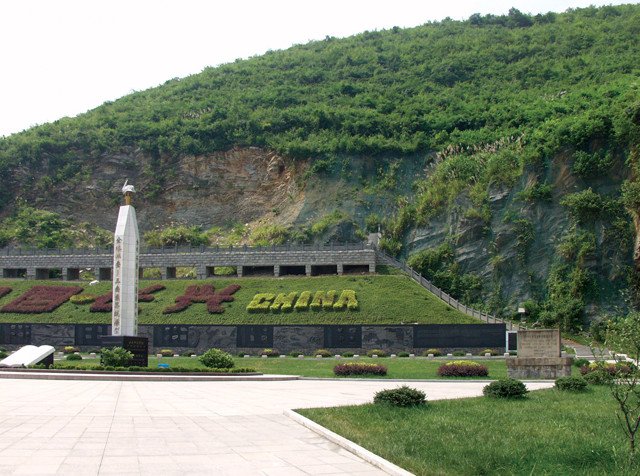
A monument commemorates the "golden spike" in Meishan, China, that marks the boundary between the Permian and Triassic periods. Credit: Shuzhong Shen.
One place that displays how the P-T marine extinction unfolded through time is in Meishan, China. Here, a Global Stratotype Section and Point, demarked by a “golden spike” driven into the rock, defines the official base of the Triassic and the end of the Permian Period. In 2014, examining the Meishan section, Shuzhong Shen of the Nanjing Institute of Geology and Paleontology at the Chinese Academy of Sciences, along with Seth Burgess and Samuel Bowring of MIT, reported in Proceedings of the National Academy of Sciences that volcanism started at approximately the same time as the extinction event, which itself started between 251,941,000 years ago, plus or minus 37,000 years, and 251,880,000 years ago, plus or minus 31,000 years.
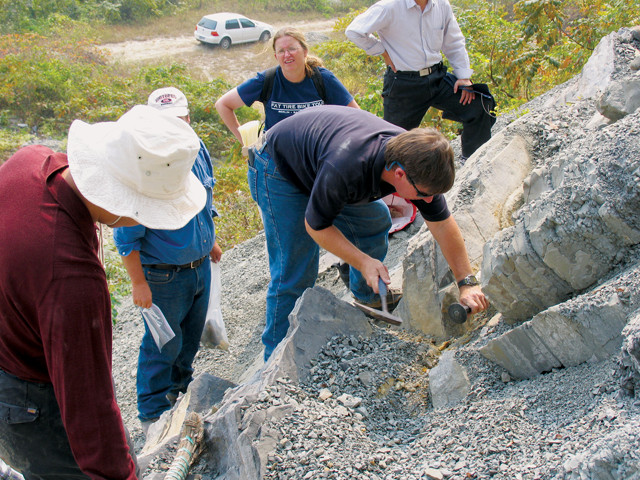
Researchers sample volcanic ash rocks from near the Permian-Triassic boundary at Meishan, China. Credit: Shuzhong Shen.
In the 1980s and 1990s, researchers thought the marine extinction took place over a relatively long stretch of time, perhaps up to 8 million years, Shen says. Now, though, using radiometric dates acquired from volcanic rocks, that time frame is thought to only be about 60,000 years, plus or minus 48,000 years, or even shorter, he says. In other words, a geologic instant.
When, exactly, the terrestrial extinction occurred, however, is not as clear, Benton says. “We’re nowhere near being able to pin it down as precisely,” he says. Part of the problem is the low resolution of the terrestrial record, which, in this case, did not form the kind of steadily accumulating rock that formed in shallow marine settings. For instance, the river sediment that makes up the stratigraphic sections in the Karoo, due to irregular floods and droughts, did not accumulate consistently through time.
Despite such poor resolution, recent work has been helping to establish precise dates for the P-T boundary on land. In a recent study in Geology, Robert Gastaldo, a paleontologist at Colby College in Maine, and colleagues, including Looy, suggest that part of the local vertebrate extirpation, in fact, occurred much earlier than the marine extinction, at roughly 253.5 million years ago — prior to the onset of volcanism, implying the need for some other extinction driver. This date, though, Benton notes, comes from just one stratigraphic horizon in the Karoo Basin, and so may not reflect what occurred globally.
There is even some question about whether the extinction of most animal groups, both on land and in the sea, occurred at the end of the Permian. Another, smaller extinction event, known as the end-Guadalupian extinction, occurred about 8 million years before the P-T event, and volcanism in what is today China seems to be a culprit. Spencer Lucas, a paleontologist at the New Mexico Museum of Natural History and Science, says that “it looks to me like that’s really the main hammer-blow to a lot of diversity.” Then, he says, “a lot of the things that are hard hit at the end of the Guadalupian stagger on for a few million years and then go extinct at the end of the Permian.” These “staggerers” include the dinocephalians, which are relatives of the dicynodonts. But again, consensus about the significance of the end-Guadalupian event is elusive. “The numerical data clearly indicate the end-Permian was much more significant [than the end-Guadalupian extinction] for vertebrates, and for marine life,” Benton says.
_NCAR.png” caption=“Maps showing the trend in six different datasets of rising sea-surface temperatures from 1982 to 2010. Warmer seas likely contributed to the P-T extinction. Credit: National Center for Atmospheric Research. Last modified May 1, 2014. "The Climate Data Guide: SST Data Sets: Overview & Comparison Table." Retrieved from climatedataguide.ucar.edu/climate-data/sst-data-sets-overview-comparison-table.” >}}
Pinning down the exact cause of the marine and terrestrial extinctions is challenging, especially since the volcanism occurred over about a million-year period, while the extinctions themselves were far quicker. “What caused such a sudden extinction [during such] long-term volcanism?” Shen asks. “This is really hard to understand.”
One factor is that global warming, due to increased levels of volcanic carbon dioxide, led to warmer oceans, Wignall says. Warmer water does not hold dissolved oxygen as easily as colder water, so lower oxygen levels, or anoxia, along with higher temperatures likely helped decimate marine life. In some places, waters were unbearably warm: At the equator, isotopic evidence from marine animal fossils suggests that ocean temperatures approached about 40 degrees Celsius at the surface. Today, equatorial sea-surface temperature highs can range from 30 to 35 degrees Celsius.
Some researchers have suggested ocean acidification may be a big factor: As carbon dioxide levels in the atmosphere rise, the oceans absorb the gas, making waters more acidic. This can impact marine life as organisms that build carbonate shells have a harder time doing so under acidic conditions. And, if severe enough, acidic seawater can also dissolve shells. But, Wignall says, “I just don’t think it was severe enough” to have had a significant impact on marine life. Increased acidity “takes hundreds of years before it starts having any significant effect” on shell building, and most organisms do not live long enough for it to become a problem, he says. It is also difficult to gauge the effects of ocean acidification on fossils, as shelly remains can dissolve away under normal conditions once the animal dies.
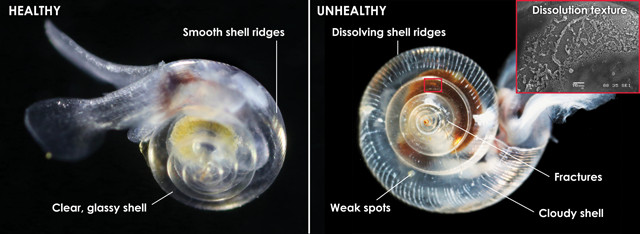
Ocean acidification is already affecting ocean creatures, like marine snails. A healthy pteropod (left) is contrasted with one affected by ocean acidification (right). Cracks and pock marks mean the shell lacks structural integrity and is more prone to predation. Ocean acidification may have played a role in the P-T extinction. Credit: all: NOAA.
Regardless, even without ocean acidification playing a large role, anoxia and increased temperatures by themselves would have been destructive enough, Wignall says.
The ultimate cause of the land extinction was also likely climate change brought on by volcanism, but as with the marine event, what exactly killed organisms off is unclear. One proposal implicates sulfur dioxide, which would have been emitted during the eruptions. Sulfur dioxide would have been “making acid rain, killing the plants, removing the roots, killing and loosening the soil,” Benton says. This is one way animals that relied on plants as a food source could have been killed off.
The eruption also would have emitted halogen gases, which include the elements fluorine and chlorine. These elements, when released into the atmosphere, can destroy ozone. Ozone in the stratosphere shields Earth’s surface from the sun’s harmful ultraviolet (UV) radiation. “Volcanism-related ozone depletion may have played an important role” in the plant extinction, Looy says. To investigate further, Wignall explains, researchers are starting to examine how biomarkers — fossils of organic molecules — changed through time during the extinction. “When plants get bathed in intense [UV radiation], they secrete chemicals that are like a sunscreen, just to help them cope,” he says. This sunscreen, which may be detectable in the form of biomarkers left behind by plants, may reveal whether or not plants responded to increased UV exposure. If they did respond, Wignall says, it will be one more step toward identifying one of the mechanisms that decimated terrestrial life.
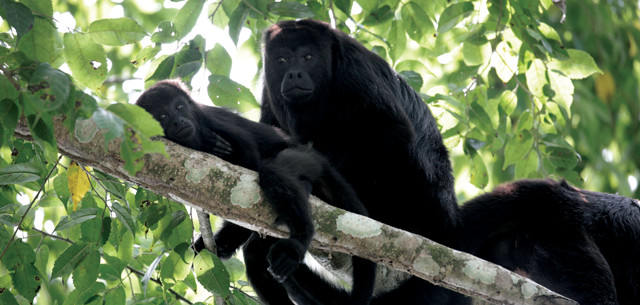
The endangered Yucatán black howler monkey has been affected by a warming climate and human impacts, including habitat decline, hunting and capture. Credit: Roberto González, CC BY 2.0.
“The P-T marine extinction boundary can be seen today on Eholmen, an island that is part of Svalbard in Norway. There, mountainsides rise and then abruptly disappear at the P-T boundary. Rock exists above the cutoff, but it is heavily weathered and eroded. Below the boundary, the rock is chert, which is an erosion-resistant silica-rich rock comprised of the remains of such marine creatures as sponges. Above, the rock is a well-eroded black shale, which forms in waters devoid of oxygen. “It’s spectacular,” Wignall says.
The rock record as a whole, though, does not always record such obvious transitions; the P-T event, as well as the other Big Five mass extinctions, are known only from those animals that actually became preserved in the fossil record. Today, for those animals facing extinction, recent research reports that many are not the kinds of organisms that have a high chance of becoming preserved as fossils. Recent research suggests that modern species loss is happening at a rate unseen over the past 66 million years, since the Cretaceous-Paleogene extinction. “Homo sapiens represent an unparalleled, incredibly dominant force on the landscape,” Looy says.
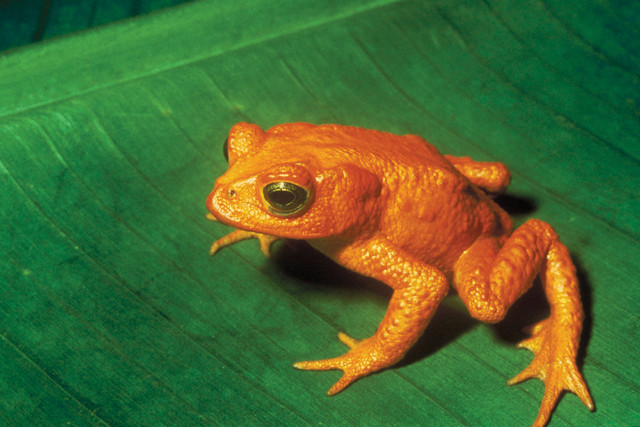
Amphibians were among the first land animals to be severely affected by modern environmental change. The golden toad of Costa Rica hasn't been seen since 1989. Credit: Charles Smith, U.S. Fish & Wildlife Service.
As the modern extinction unfolds — driven by anthropogenic alteration of the environment — it may help us understand how the P-T extinction itself played out. “I think some of the answers to our P-T questions are going to come from our own understanding of … the chemistry of the atmosphere today,” Wignall says. “We’re starting to see changes that will take hundreds [of years] to a few thousand years to occur.”
The kill mechanisms are the biggest remaining questions. Carbon dioxide emissions appear to be similar in the P-T to what we’re emitting today, but the similarity may end there, Wignall says. “Today we’re not creating the end-Permian mass extinction,” he says. So something more is going on: Either we aren’t emitting as much carbon dioxide today as what happened at the P-T boundary, “or you could argue there are delayed effects,” meaning the full effects of today’s emitted carbon dioxide on the biosphere have yet to manifest. “We just don’t understand, basically,” he says.
One strong similarity between the P-T and modern extinctions, Looy says, may be the possibility that a spike in global temperature contributed to the heightened extinction rates — almost all species disappearing over just tens of thousands of years — during the P-T event. If today’s changes turn out to be similar to those that yielded the P-T event, Gastaldo says, we could one day be facing “similar rates of ecosystem collapse that would be devastating for the smartest and most advanced species on the planet, Homo sapiens.”
© 2008-2021. All rights reserved. Any copying, redistribution or retransmission of any of the contents of this service without the expressed written permission of the American Geosciences Institute is expressly prohibited. Click here for all copyright requests.